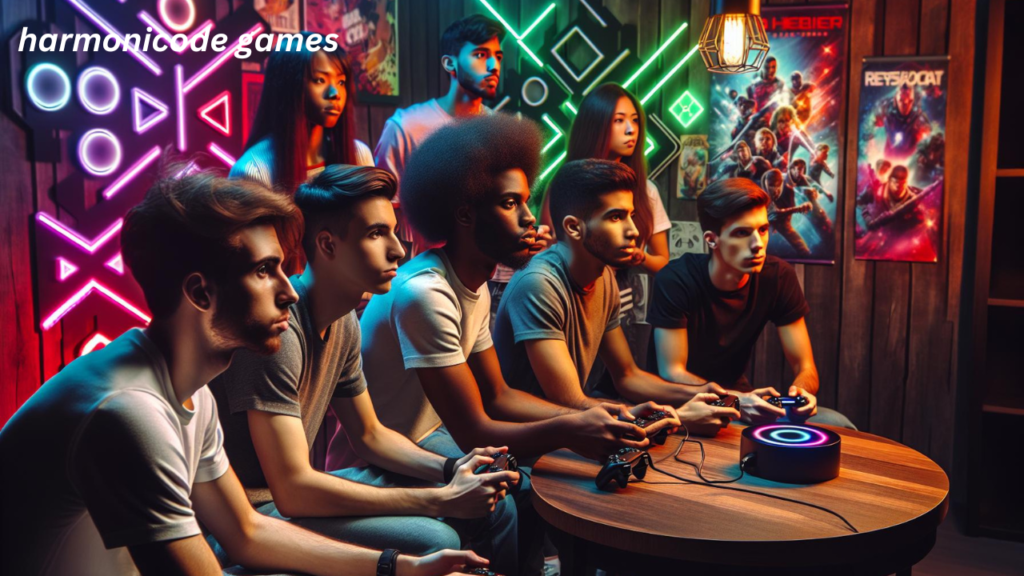A Deep Dive into Harmonicode Games Where Sound Meets Strategy

In the ever-evolving world of gaming, innovation is key. Game developers are constantly searching for fresh ideas to push boundaries and deliver experiences that captivate players. One of the most exciting and recent innovations in the gaming industry is the emergence of harmonicode games. These games seamlessly combine the power of music, sound, and strategic gameplay to create something truly unique. In this article, we will explore what harmonicode games are, how they work, and why they are becoming increasingly popular among players worldwide.
What Are Harmonicode Games?

Harmonicode games are a genre of interactive entertainment that blends musical elements with traditional gaming mechanics. The core concept behind harmonicode games is to use sound, rhythm, and music as fundamental parts of gameplay. This can range from using music as a way to control the in-game environment to leveraging sound cues for strategic decision-making.
The “code” part of harmonicode refers to the integration of programming and algorithms into the game design, where sound and music are not just added as background elements, but are embedded into the core mechanics of the game itself. It’s not just about playing the right notes or rhythms but also about utilizing those sounds as tools for strategic thinking and problem-solving. Harmonicode games require players to be in tune with the musical elements of the game in order to progress, making the combination of sound and strategy essential for success.
How Do Harmonicode Games Work?
The mechanics of harmonicode games can vary widely depending on the game’s design and the specific role that music plays. However, a few key features typically define the genre:
Music as a Gameplay Mechanic
In harmonicode games, music is not just an auditory experience but an integral gameplay element. For example, a player might need to press buttons in time with the music, or specific melodies or beats may trigger events within the game world. Some games require players to compose or remix tracks to solve puzzles or defeat enemies.
Sound-Based Strategy
In some harmonicode games, players must listen carefully to the in-game sounds to make informed decisions. A shift in musical tones or rhythms might signal a change in the game’s environment, alerting the player to new threats, opportunities, or objectives. Sound cues can be used as indicators for where to move, when to attack, or how to manipulate the game world.
Algorithmic Sound Generation
Many harmonicode games use procedural generation algorithms to create unique soundscapes for each playthrough. The in-game music may be generated dynamically based on the player’s actions or the game’s events. This can create an immersive experience where the music adapts to the player’s decisions, making each playthrough feel fresh and unique.
Musical Puzzle Solving
Puzzle-solving in harmonicode games often revolves around understanding musical patterns or rhythms. Players may need to decode a melody or recognize harmonic structures to unlock new areas or progress in the game. These puzzles can range from simple rhythm matching to complex compositions that require a deep understanding of music theory.
The Impact of Harmonicode Games on the Gaming Experience
Harmonicode games represent a major shift in how sound and music are perceived in video games. Traditionally, music in games has been a supplementary element, setting the mood or tone of the environment. In harmonicode games, however, music takes on a central role, influencing gameplay directly. This shift opens up new possibilities for game design, offering experiences that challenge players not only to think critically but to engage with music on a deeper level.
Enhanced Immersion
By incorporating sound as a central gameplay element, harmonicode games enhance player immersion. Players are not just passive listeners; they actively engage with the music, making their decisions based on the rhythm, melody, and harmony around them. This creates a more dynamic and interactive experience, where players feel like they are part of the music they are experiencing.
Engaging Auditory Challenges
The combination of music and strategy in harmonicode games presents players with unique auditory challenges. Instead of relying solely on visual cues, players must develop their ability to interpret sound and rhythm, creating a more engaging and multi-sensory experience. This can attract a wide range of players, from those with a deep interest in music to those seeking a more mentally stimulating gaming experience.
Appealing to Music Lovers
For players who are passionate about music, harmonicode games offer a special kind of gameplay experience. These games provide an opportunity to immerse oneself in the world of music theory, composition, and rhythm while also engaging in traditional gaming mechanics. Whether a player is creating their own soundtracks, solving musical puzzles, or experiencing algorithmic compositions, harmonicode games offer something for every music lover.
Popular Harmonicode Games: Examples to Explore
While harmonicode games are still a relatively niche genre, there are a few standout titles that have already captured the imagination of players. These games showcase the innovative ways that music and sound can be integrated into gameplay.
Crypt of the NecroDancer
One of the most well-known examples of harmonicode games is Crypt of the NecroDancer. In this game, players must move and attack to the beat of the music. The rhythm-based combat and dungeon crawling mechanics create a unique blend of strategy and sound. Players must not only plan their moves but also pay close attention to the changing beats and rhythms of the soundtrack, making each battle a rhythmic challenge.
Thumper
Thumper is another excellent example of a harmonicode game. Dubbed as a “rhythm violence” game, Thumper places players in the role of a space beetle, racing through a psychedelic world while avoiding obstacles and defeating enemies. The game’s intense music and sound design are essential for gameplay, as players must time their movements and actions to the beat to survive.
Rez Infinite
Rez Infinite combines rail-shooter gameplay with music, offering a synesthetic experience where each shot and movement is in sync with the game’s electronic soundtrack. The visual and auditory elements of the game work in tandem, creating a cohesive experience that blends action and rhythm.
Beat Saber
Though not strictly a harmonicode game, Beat Saber incorporates rhythm-based gameplay with strategic elements. Players use lightsabers to slice through blocks in time with the music, adding a layer of strategy as they navigate the different speeds, rhythms, and directions of the blocks. The immersive sound and visuals are key components of the gameplay, making it a great entry point for those interested in music-based games.
Why Harmonicode Games Are the Future of Gaming
The rise of harmonicode games marks a pivotal moment in the evolution of gaming. As technology continues to advance, the integration of sound and music into the gaming experience is only going to become more sophisticated. By blending strategy with musical creativity, these games offer players an immersive and challenging experience that can’t be found in traditional games.
Furthermore, the growth of virtual reality (VR) and augmented reality (AR) technologies could take harmonicode games to the next level. Imagine a VR game where players must physically move and interact with sound elements in a 360-degree environment. The possibilities are endless, and as more developers experiment with sound-based mechanics, we can expect to see even more innovative titles in the future.
The Future of Harmonicode Games
Looking ahead, harmonicode games are set to expand and evolve in exciting new ways. As players become more accustomed to the idea of sound-driven gameplay, we will likely see more complex and immersive titles emerge. Game developers may experiment with incorporating different genres of music, ranging from classical to electronic, to create even more diverse experiences. Additionally, multiplayer harmonicode games could allow players to collaborate and compete in rhythm-based challenges, further enhancing the social aspect of gaming.
In conclusion, harmonicode games represent a fascinating intersection of music, sound, and strategy, offering players a fresh and engaging gaming experience. As the genre continues to develop, it is clear that harmonicode games have a bright future ahead, with the potential to revolutionize the way we think about and interact with music in the world of gaming.
FAQs
What are harmonicode games?
Harmonicode games are a genre of video games where music and sound play a central role in gameplay. Players engage with sound, rhythm, and music in strategic ways to solve puzzles, defeat enemies, and progress in the game.
How does music influence gameplay in harmonicode games?
In harmonicode games, music influences gameplay by acting as a mechanic. Players may need to follow a rhythm, match beats, or interpret sound cues to make strategic decisions and solve challenges.
Can harmonicode games be played by those who aren’t musically inclined?
Yes! While harmonicode games may appeal to music lovers, they are designed to be accessible to all players. The games often offer intuitive mechanics and may even provide learning opportunities for those less familiar with music theory.
What are some examples of popular harmonicode games?
Some well-known harmonicode games include Crypt of the NecroDancer, Thumper, Rez Infinite, and Beat Saber. Each of these games incorporates music and rhythm into the gameplay in unique ways.
Are harmonicode games the future of gaming?
Harmonicode games have the potential to be a major part of the future of gaming. As technology continues to improve, the integration of sound and music into gameplay will become more sophisticated, offering players deeper and more immersive experiences.
You May Also Read: https://sfmcompile.org.uk/nebunexa-co/



